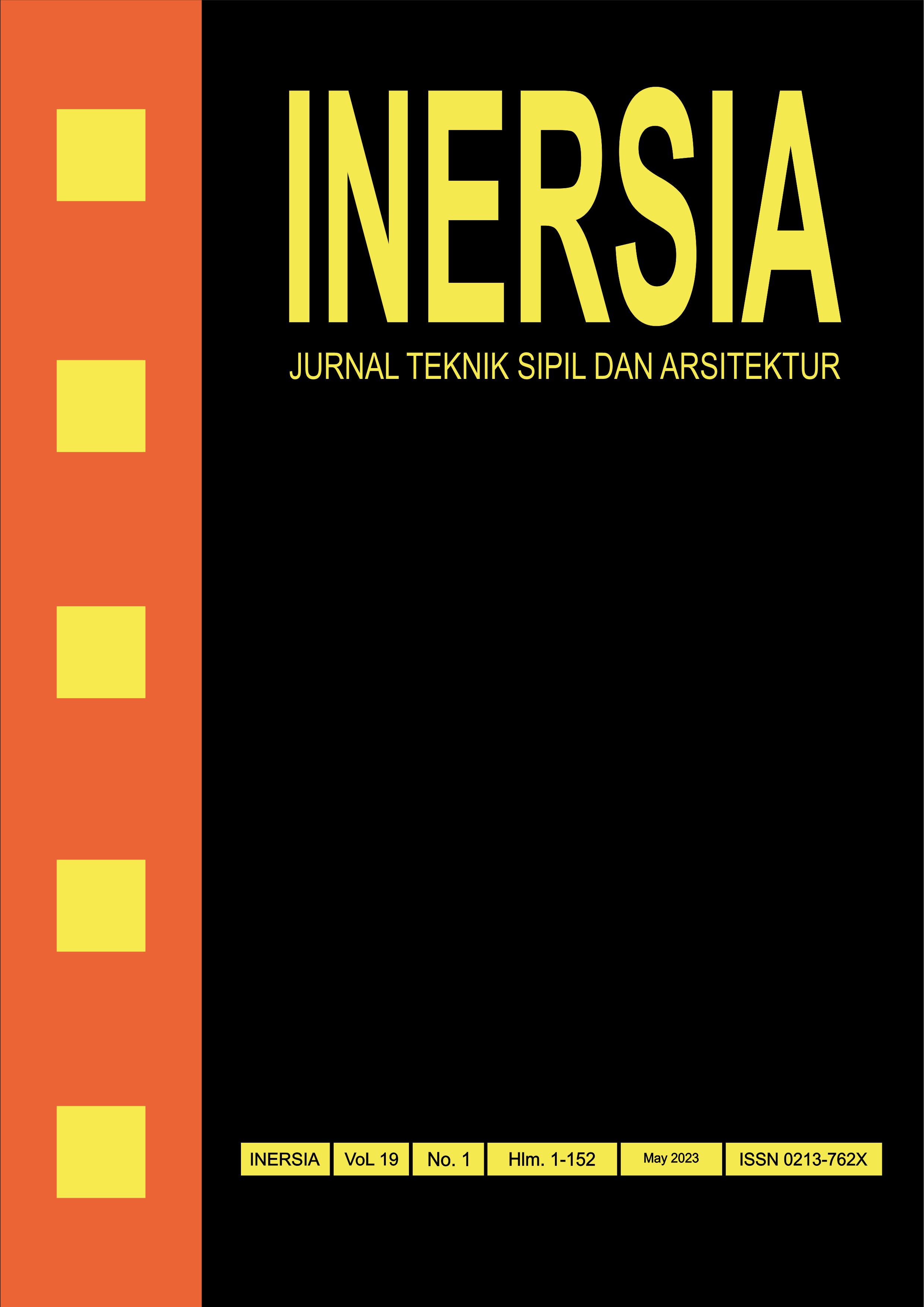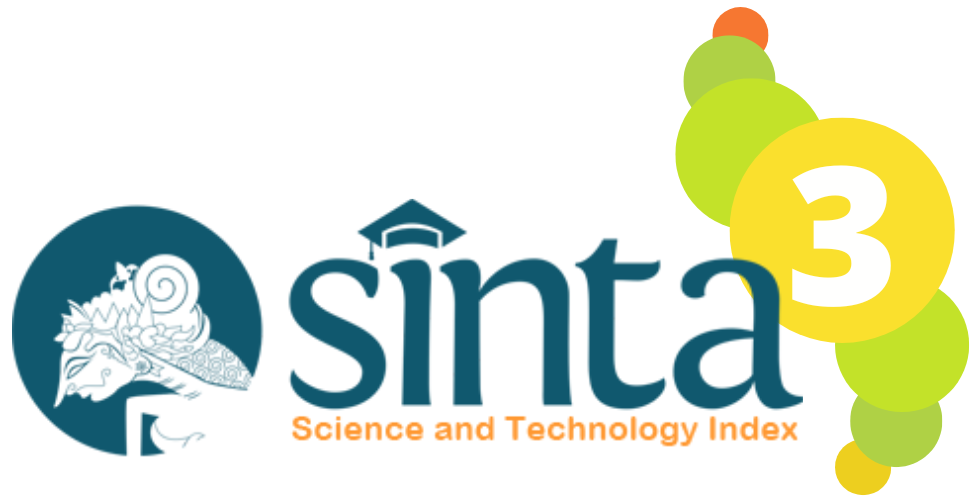Modification of Used Rubber Tire Mortar with Fly Ash Addition
DOI:
https://doi.org/10.21831/inersia.v19i1.57722Keywords:
Used rubber tire mortar, Fly ash Mortar, compressive strengthAbstract
Used tire rubber mortar has been studied for its physical, mechanical, and dynamic properties. Adding used tire rubbers to the mortar is considered effective in improving the brittle properties of the mortar, as well as increasing the mortar's elasticity and damping ability. However, the higher the tire rubber content, the lower the strength of the mortar. Therefore, the use of tire rubber mortar has some limitations. This study investigates the possibility of fly ash as an admixture in tire rubber mortar to enhance its compressive strength. The compressive strength test follows the provisions of ASTM C-109, with a cube-shaped test object measuring 5x5x5 cm3. The specimen type consists of normal mortar, 30%, and 40% tire rubber mortar. Variations in fly ash content are 0%, 5%, 10%, 15%, 20%, 25%, and 30%, respectively. Compressive strength tests were conducted when the mortar was 14, 28, and 56 days. With five specimens for each variation, 245 specimens were tested. The test results show that adding fly ash can be recommended to increase the compressive strength of tire rubber mortar, with a maximum content of 20% by weight of cement. The tire rubber mortar with fly ash mixture experienced a significant strength in 28 – 56 days due to the escalation of fly ash adhesion between the rubber paste and cement.
References
P. RI, PP No. 27 Tahun 2020 tentang Pengelolaan Sampah Spesifik, no. PP No.7 th.2020. 2020.
M. L. Rochman and M. Setiyo, "Mini Review: Potensi Limbah Ban Menjadi Bahan dan Produk yang Berguna," Jurnal Teknik Mesin Institut Teknologi Padang, vol. 9, no. 1, p. 7, 2019.
D. M. Sadek and M. M. El-Attar, "Structural behavior of rubberized masonry walls," Journal of Cleaner Production, vol. 89, pp. 174–186, Feb. 2015, doi: 10.1016/j.jclepro.2014.10.098.
S. A. Alfayez, A. R. Suleiman, and M. L. Nehdi, "Recycling Tire Rubber in Asphalt Pavements: State of the Art," Sustainability, vol. 12, no. 21, p. 9076, Oct. 2020, doi: 10.3390/su12219076.
R. Faizah, H. Priyosulistyo, and A. Aminullah, "Sifat Fisik dan Mekanik Mortar dengan Campuran Serutan Karet Ban Bekas Berbagai Merk," Jurnal Teknik Sipil, vol. 27, no. 2, pp. 117-126–126, Aug. 2020, doi: 10.5614/jts.2020.27.2.2.
B. Ajmera, B. Tiwari, and J. Koirala, "Geotechnical Properties of Clays Modified with Recycled Crumb Rubber," in Geotechnical and Structural Engineering Congress 2016, Phoenix, Arizona, Feb. 2016, pp. 1404–1413. doi: 10.1061/9780784479742.117.
L. N. Snodi and I. S. Hussein, "Tire Rubber Waste for Improving Gypseous Soil," Materials Science and Engineering, p. 7, 2019.
B. S. Thomas and R. C. Gupta, "A comprehensive review on the applications of waste tire rubber in cement concrete," Renewable and Sustainable Energy Reviews, vol. 54, pp. 1323–1333, Feb. 2016, doi: 10.1016/j.rser.2015.10.092.
A. A. Aliabdo, A. E. M. Abd Elmoaty, and M. M. AbdElbaset, "Utilization of waste rubber in non-structural applications," Construction and Building Materials, vol. 91, pp. 195–207, Aug. 2015, doi: 10.1016/j.conbuildmat.2015.05.080.
M. A. Hendrawan and P. I. Purboputro, "Studi Karakteristik Sifat Mekanik Kompon Karet dengan Variasi Komposisi Sulfur dan Carbon Black sebagai Bahan Dasar Ban Luar," in Simposium Nasional Teknologi Terapan (SNTT) 3, 2015, p. 8.
S. Yang, R. A. Lohnes, and B. H. Kjartanson, "Mechanical Properties of Shredded Tires," Geotechnical Testing Journal, GTJODJ, vol. 25, no. 1, pp. 44–52, Mar. 2002.
R. Faizah, H. Priyosulistyo, and A. Aminullah, "The Properties of Waste Rubber Tires in Increasing the Damping of Masonry Wall Structure," in IOP Conference Series: Materials Science and Engineering, Universitas Tarumanegara Jakarta, Oct. 2019, vol. 650, p. 012041. doi: 10.1088/1757-899X/650/1/012041.
R. Faizah, H. Priyosulistyo, and A. Aminullah, "An Investigation on Mechanical Properties and Damping Behaviour of Hardened Mortar with Rubber Tire Crumbs (RTC)," MATEC Web Conf., vol. 258, p. 05002, 2019, doi: 10.1051/matecconf/201925805002.
B. Liu, S. Yang, W. Li, and M. Zhang, "Damping dissipation properties of rubberized concrete and its application in anti-collision of bridge piers," Construction and Building Materials, vol. 236, p. 117286, Mar. 2020, doi: 10.1016/j.conbuildmat.2019.117286.
M. Bekhiti, H. Trouzine, and A. Asroun, "Properties of Waste Tire Rubber Powder," vol. 4, no. 4, p. 4, 2014.
R. Faizah, "Perilaku Dinamik Dinding Pasangan Bata In-plane Menggunakan Spesi Mortar Serutan Karet Ban Bekas," Dissertation, Universitas Gadjah Mada, Yogyakarta, Indonesia, 2021.
R. Faizah, "Perilaku Dinamik Dinding Pasangan Bata In-plane Menggunakan Spesi Mortar Serutan Karet Ban Bekas," Dissertation, Universitas Gadjah Mada, Yogyakarta, Indonesia, 2021.
M. Setiawati, "Fly Ash Sebagai Bahan Pengganti Semen Pada Beton," in Seminar Nasional Sains dan Teknologi 2018, Jakarta, 2018, p. 8. [Online]. Available: jurnal.umj.ac.id/index.php/semnastek
T. Takada et al., "Utilization of coal ash from fluidized-bed combustion boilers as road base material," Resources, Conservation and Recycling, vol. 14, no. 2, pp. 69–77, Aug. 1995, doi: 10.1016/S0921-3449(95)80001-8.
S. Wang and H. Wu, "Environmental-benign utilisation of fly ash as low-cost adsorbents," Journal of Hazardous Materials, vol. 136, no. 3, pp. 482–501, Aug. 2006, doi: 10.1016/j.jhazmat.2006.01.067.
E. Cokca and Z. Yilmaz, "Use of rubber and bentonite added fly ash as a liner material," Waste Management, vol. 24, no. 2, pp. 153–164, Jan. 2004, doi: 10.1016/j.wasman.2003.10.004.
P. Chindaprasirt, T. Chareerat, and V. Sirivivatnanon, "Workability and strength of coarse high calcium fly ash geopolymer," Cement and Concrete Composites, vol. 29, no. 3, pp. 224–229, Mar. 2007, doi: 10.1016/j.cemconcomp.2006.11.002.
A. Yilmaz and N. Degirmenci, "Possibility of using waste tire rubber and fly ash with Portland cement as construction materials," Waste Management, vol. 29, no. 5, pp. 1541–1546, May 2009, doi: 10.1016/j.wasman.2008.11.002.
R. Yanita and A. Sagab, "Pemanfaatan Bahan Limbah untuk Campuran Bahan Plesteran," vol. 1, p. 10.
T. Qi, G. Feng, Y. Zhang, J. Guo, and Y. Guo, "Effects of Fly Ash Content on Properties of Cement Paste Backfilling," JRST, vol. 12, no. 3, pp. 133–141, 2015, doi: 10.12783/issn.1544-8053/12/3/3.
ASTM, Standard Test Method for Compressive Strength of Hydraulic Cement Mortars (Using 2-in or (50-mm) Cube Specimens). 2007, p. 9.
BSN, Metode Pengujian Kekuatan Tekan Mortar Semen Portland untuk Pekerjaan Sipil. 2002.
M. A. Mutar, T. S. Hussein, and S. H. Malik, "Effect of Crumb Rubber Aggregates on the Characteristics of Cement Concrete as Partial Replacement," International Journal of Mechanical and Production Engineering Research and Development (IJMPERD), vol. 8, no. 1, p. 11, 2018.
O. Youssf, M. A. ElGawady, J. E. Mills, and X. Ma, "PREDICTION OF CRUMB RUBBER CONCRETE STRENGTH," p. 7, 2014.
BSN, Tata cara Rencana Pembuatan campuran Beton Ringan dengan Agregat Ringan, vol. SNI 03-3449-2002.
Downloads
Published
How to Cite
Issue
Section
License
Authors who publish with INERSIA journal agree to the following terms:
- Authors retain copyright and grant the INERSIA journal right of first publication with the work simultaneously licensed under Creative Commons Attribution License (CC BY 4.0) that allows others to share the work with an acknowledgment of the work's authorship and initial publication in this journal.
- Authors can enter into separate, additional contractual arrangements for the non-exclusive distribution of the published version of the work (e.g., post it to an institutional repository or edit it in a book), with an acknowledgment of its initial publication in this journal.
- Authors are permitted and encouraged to post their work online (e.g., in institutional repositories or on their website) before and during the submission process, as it can lead to productive exchanges, as well as earlier and greater citation of published work.

INERSIA by https://journal.uny.ac.id/index.php/inersia was distributed under a Creative Commons Attribution 4.0 International License











